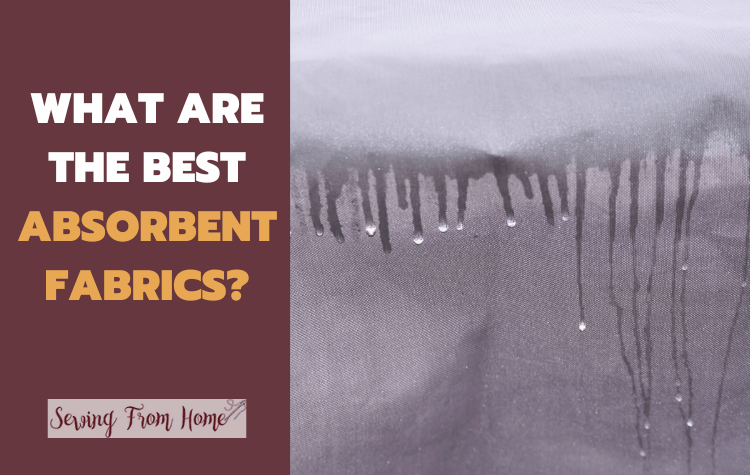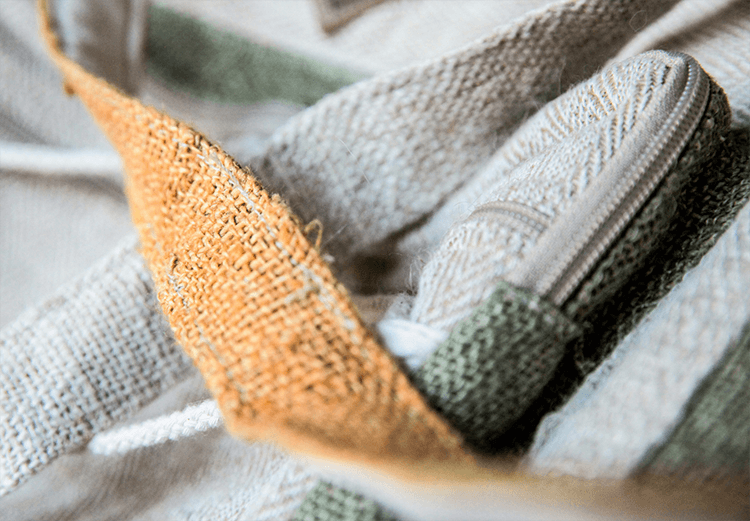With each sewing project comes the need to choose fabrics that are fit for the task. Depending on the project, your fabric will need to possess the properties that ensure it’s the right choice for the garment you’re making.
Absorbency is one such factor.
While all fabrics are absorbent to a certain degree, each fabric type will be better suited to a different type of project, depending on your specific needs. Some of the best absorbent fabrics are hemp, bamboo, cotton, wool, zorb, and terry cloth. Each has its pros and cons for specific projects.
When deciding which fabric to use for your project, you will need to consider how much absorbency is required, the comfort of the fabric on the skin, warmth, and various other factors.
By weighing up your needs against the capabilities of the fabric in question, you will be able to find the perfect choice for your needs.
Why Would You Need Absorbent Fabrics?

The degree to which a fabric needs to be absorbent will depend entirely on the project.
Various items require a certain degree of moisture absorption. Each type of item requires moisture absorption to a different degree, and you will need to choose carefully to ensure that the fabric you have in mind will be able to perform as required.
Some of the everyday items that may require absorbent fabrics include:
- Washcloths
- Underwear
- Reusable wipes
- Sportswear
- Towels
Absorbent fabrics are also particularly useful in various – almost all – items for baby use. These include:
- Diaper inserts
- Burp cloths
- Reusable diapers
- Dribble bibs
Absorbent fabrics are also required in numerous homeware fabrics. This includes, but is not limited to:
- Bed sheets
- Mattress covers
There are also various items of adult and children’s clothing that require a certain degree of moisture absorbency, such as:
- Loungewear
- Exercise clothing
- Beachwear
- Robes
- Wraps
Absorbent fabrics also extend into the feminine hygiene space, where they are used to make reusable hygiene pads to accommodate the menstrual cycle. Absorbent fabrics are also required for breast pads.
Other miscellaneous items that may require absorbent fabrics include:
- Yoga towels
- Pet beds
Each of the items above will have different requirements for moisture absorption.
For example, reusable fabric diapers require a fast drying fabric that holds liquid extremely well.
If the fabric is not overly thick, it may also be better for a diaper. It will also need to be soft to ensure the baby’s comfort. Diapers also usually use a secondary fabric to cover the more absorbent fabric, ensuring maximum comfort overall.
For example, the fabric used here will need to be significantly different if you’re looking at menstrual pads. The fabric used for menstrual pads must be relatively trim, and it must be easily washable.
Many women will prefer natural fibers over synthetic options. These are often covered by a secondary fabric that comes into contact with the skin.
On the other hand, a breast pad will need to hold onto liquid very well and remain soft when washed. Natural fiber is also usually preferred to the synthetic type, and it should be relatively trim to ensure maximum comfort.
As you can see, there’s a lot to consider when choosing what type of absorbent fabric will be best suited to a given project!
What is Fabric Absorbency?
The fabric’s absorbency refers to how much liquid it can take in and retain within its fibers. Fabrics are made of thin threads. These threads are made up of various fibers that have been twisted together. The shape of the fiber will determine how absorbent the fabric is overall.
It’s important to remember that there is a significant difference between moisture-absorbing and moisture-wicking fabrics.
Moisture Wicking vs Moisture Absorbing
Moisture-wicking fabrics will remove the moisture from your skin and retain it on the fabric’s external surface. Moisture-absorbing fabrics will actually hold the moisture within their fibers.
Fabrics that can absorb water are referred to as hydrophilic.
See more: the best water resistant fabrics
Rather than considering the type of fabric, a more important consideration is the grams per square meter of the respective fabric and its fibers.
Any fabric with a GSM lower than 400 will not be highly effective at absorbing moisture as required.
An effective fabric will require a GSM factor of 400 to 600. Anything above this number is considered a luxury fabric.
What to Look For in an Absorbent Fabric
When choosing an absorbent fabric, you must whether it needs to be fast-drying. You should consider whether you would prefer a natural fiber or if a synthetic one will do the job effectively.
Also, consider whether the fabric will touch your skin or not, as this will make a major difference to the comfort factor.
You must also think about the trim of the fabric in question and whether it is a cheap fabric or not. Whether you are going to use the fabric in layers or not is also key.
You should also determine whether the fabric requires pre-shrinking or not.
For example, natural fibers are often your best option with an item such as a towel, as they are better able to absorb a higher amount of liquid mess than synthetic options.
What Are The Best Absorbent Fabrics?
Some of the best absorbent fabrics include terry cloth, zorb, wool, cotton, microfiber, bamboo, and hemp.
There are several variations within each of these fabric types that will serve your needs in different ways.
Hemp
Hemp is a brilliant absorbent fabric for various reasons.
Firstly, it is hypo-allergenic, making it suitable for any allergy sufferers. This also means it will be gentle on your skin, ensuring you do not run into any issues with discomfort.
Hemp is light while remaining warm. It is also extremely breathable, giving it a major advantage.

Hemp is also very long-lasting and eco-friendly. Hemp is a highly absorbent fabric, and it is made of natural fibers, which is preferable in many instances. How the fibers have been arranged allows any moisture to be extracted easily from your skin.
Hemp is relatively expensive, however, so it can rack up the cost of your next project.
Cotton
Cotton is probably the most widely used absorbent fabric. It is cheap and widely available, making it a great choice as an absorbent fabric. Cotton can also dries very quickly, often making it an attractive option for any project requiring moisture absorption.
There are various types of cotton available. Some of these are more absorbent than others. For example, cotton knit is far more absorbent than woven cotton.
Zorb
Zorb is an artificial fabric produced by Wazoodle fabrics. It has incredible moisture absorbing capabilities and can absorb ten times its weight in moisture within a two-second timeframe.
This makes this fabric far faster absorbent than most other fabrics such as bamboo, cotton, and hemp.
Zorb fabrics are, however, somewhat susceptible to compression leaks. This means that if the fabric is compressed, it will release the moisture it has absorbed. This can make this fabric less desirable for use in certain applications.
Bamboo
Bamboo fabric is an affordable option with a host of benefits. It is highly absorbent and extremely soft. Bamboo is also subjected to far fewer chemical processes during its manufacturing process.
This means that there will be far less chance of your skin reacting negatively when making contact with the fabric.
Compared to cotton, bamboo is also far more fluffy and silky. It is also highly resistant to germs and fungus, making it a far healthier option. Bamboo tends to become softer with more frequent use.
Wool
Wool is an extremely absorbent natural fiber. It is also warm while remaining breathable. Wool is good at temperature regulation, and its antimicrobial properties make it a great option for use as an absorbent fabric.
Terry Cloth
Terry cloth is a widely used fabric, especially in toweling. Its ability to absorb comes from how it is woven, with its pile loops helping to draw in moisture. Besides towels, this fabric is also great for loungewear, robes, beachwear, and wraps.
There are various types of Terry Cloth, such as the Cuddle type. This features a waffle pattern that minimizes the surface area that comes into contact with the skin. It is best used for washcloths, beachwear, and other baby items.
Microfiber
Microfiber fabric comprises plastic fibers – polyester and polyamide – that are thin and tightly packed. This ensures that it can be extremely absorbent. It is often used for diapers but requires a liner to ensure it does not touch the baby’s skin.
While microfiber is somewhat affordable, it has a shorter lifespan than many other fabrics.
Final Thoughts
Choosing the best absorbent fabric requires a good understanding of the end-use of your creation.
This decision is project-specific, as each item will have different moisture-absorbing requirements. As a result, you must weigh the pros and cons of various fabrics and their moisture absorbency before deciding.
